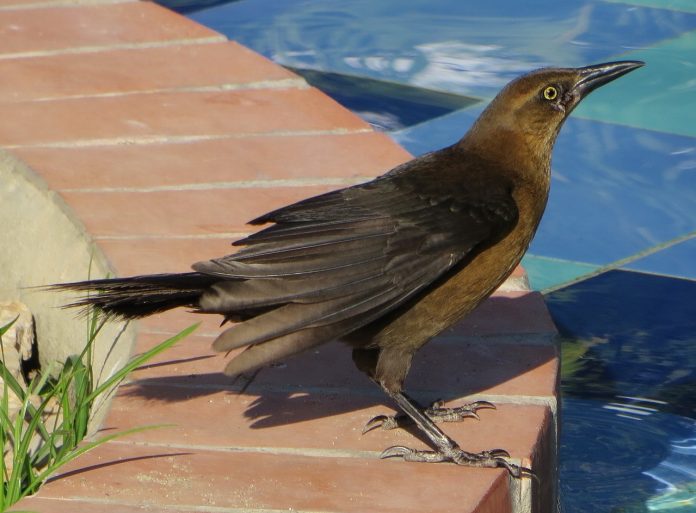Every spring I get reports from astonished readers describing a small bird feeding a much larger, obviously begging chick. Can you explain this, readers ask.
The answer is “brood parasitism.” Brown-headed cowbirds are members of the blackbird family, and they are brood parasites; they lay their eggs in the nests of other birds.
It’s an admirable reproductive strategy. Why build a nest, incubate the eggs, and raise young when other birds will do it for you?
Though cowbirds are known to parasitize the nests of more than 200 species of birds, song sparrows, chipping sparrows, red-eyed vireos, and indigo buntings are among the most frequent victims.
Common sight
Brown-headed cowbirds are common on farmland, forest edges and at feeders. Males have shiny black bodies with distinctly brown heads. Females are uniformly grayish brown. Presumably, the cowbird’s parasitic lifestyle originated on western prairies where they lived in association with huge herds of bison that once roamed the Great Plains. Cowbirds ate insects kicked up by the bison as they grazed their way across the prairie.
Bison, however, did not stay in one place long enough for cowbirds to build their own nests and raise broods, so cowbirds adopted the parasitic lifestyle. This strategy enables cowbirds to avoid most of the work associated with reproduction.
Building a nest, defending a territory, incubating eggs, and feeding young are time-consuming and energy-demanding chores. Cowbirds avoid these responsibilities by parasitizing other birds’ nests. Beginning in April and continuing well into summer, female cowbirds invest hours each morning from treetop perches watching the comings and goings of other birds to locate their nests.
After the unsuspecting potential host lays an egg, the female cowbird slips in and lays an egg of her own. Before laying the egg, she sometimes removes one of the host eggs. A female lays one egg per day for five or six days.
After a few days rest, she repeats the process. In the 1880s, cowbirds expanded their range eastward as settlers tamed and divvied up the vast eastern forests into small fragmented family farms. The cowbird’s common name acknowledges the obligatory relationship between the birds and grazing livestock.
Today, cowbirds inhabit all but the most densely forested areas in the lower 48 states. The female cowbird’s reproductive strategy is ingenious. While most songbirds raise two broods of four or five chicks per nest, a female cowbird can lay as many as 40 eggs over the course of the nesting season.
By using foster parents, she is freed from the duties of incubation and brood rearing. After the eggs are laid, cowbirds have a distinct advantage. Cowbird eggs are usually larger than host eggs, they hatch sooner than host eggs, and cowbird hatchlings are bigger and grow faster than host hatchlings.
After hatching, the cowbirds out-compete host chicks for food and sometimes throw the host chicks out of the nest. When parent birds bring food to the nest, they usually feed the chicks that beg most vigorously.
Eating behaviors
Larger cowbird chicks reach higher and more vigorously than host chicks. This can lead to foster parents’ own chicks starving. The net effect of brood parasitism is tantamount to predation. And when cowbirds fledge, they are usually larger than the adult hosts that raised them.
This explains why we sometimes see smaller adult birds feeding much larger chicks. The instinct to incubate whatever eggs a nest contains is powerful, but some birds can recognize cowbird eggs.
Catbirds and robins, for example, remove cowbird eggs from their nests. And yellow warblers sometimes abandon parasitized nests or build a new nest on top of the one that contains cowbird eggs.
A classic photo in an ornithology textbook depicts a three-story yellow warbler nest that buried two layers of cowbird eggs. Most people never notice cowbird parasitism until they see a small adult bird feeding a much larger fledgling.
It’s a scene that makes no sense without an understanding of cowbird biology.













